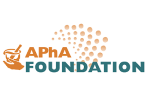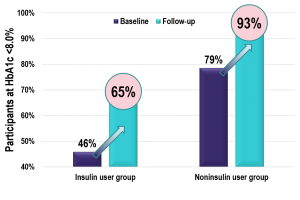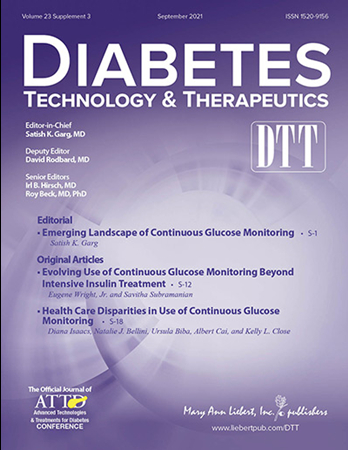CGM Technology and Digital Health
Source: AMCP Science and Innovation Theater Webinar – February 16, 2022
Key Takeaway:
The Dexcom CGM system is unique with the ability to connect with multiple digital health solutions. Combining CGM with digital health apps allows users to quickly see all their data in one place. Access to real-time data can empower people with diabetes and foster patient engagement with in-the-moment diabetes feedback and the opportunity for coaching.
The recently updated American Diabetes Association (ADA) Standards of Care (SOC) 20221 revised the technology recommendations focusing on use of continuous glucose monitoring (CGM). In addition, the ADA added digital health to the recommendations noting the opportunity for digital coaching as a tool for education. Join this webinar for a deep dive into the updated CGM technology SOC and learn about the current evidence that influenced recent changes. Diabetes technology is evolving rapidly, stay up to date with CGM to enhance your knowledge.
1. American Diabetes Association. Diabetes Care. 2022;45(Suppl1):S97-S112
Learn More
American Association of Clinical Endocrinology Clinical Practice Guideline: The Use of Advanced Technology in the Management of Persons With Diabetes Mellitus
Source:
The American Association of Clinical Endocrinology (AACE) with a task force of medical experts developed evidence-based guideline recommendations regarding the use of advanced diabetes technology in clinical settings. The guidelines reveal that ensuring universal access to advanced diabetes technologies is anticipated to result in improved glycemia and allowing more persons with diabetes to achieve glycemic targets, improve quality of life, and potentially reduce burden of care. Furthermore, diabetes technology can improve the efficiency and effectiveness of clinical decision-making.
Featured Segments
- CGM is strongly recommended for all persons with diabetes treated with intensive insulin therapy, defined as 3 or more injections of insulin per day or an insulin pump1
- CGM is recommended for:
- All individuals with problematic hypoglycemia (frequent/severe hypoglycemia, nocturnal hypoglycemia, hypoglycemia unawareness).2
- Children/adolescents with T1D.2
- Pregnant women with T1D and T2D treated with intensive insulin therapy.2
- Women with gestational diabetes mellitus (GDM) on insulin therapy.3
- CGM may be recommended for:
- Women with GDM who are not on insulin therapy.3
- Individuals with T2D who are treated with less intensive insulin therapy.4
| Real-time CGM should be recommended over intermittently scanned CGM for: | isCGM should be considered for: |
|
|
1Grade A; High Strength of Evidence; BEL 1; 2Grade A; Intermediate-High Strength of Evidence; BEL 1; 3Grade A; Intermediate Strength of Evidence; BEL 1; 4Grade B; Intermediate Strength of Evidence, BEL 1; 5Grade B; Low-Intermediate Strength of evidence; BEL; 6Grade D; Low Strength of Evidence/Expert Opinion of Task Force; BEL
Learn MoreWatch the APhA 2021 Annual Meeting and Exposition Presentation Theatre on the power of real-time continuous glucose monitoring, featuring:
Dr. Diana Isaacs
Endocrine Clinical Pharmacist & Remote Monitoring Program Coordinator
Cleveland Clinic
Dr. Jessica Haskins
Community Walgreens Site Manager
Austin, TX

Source: Association of Diabetes Care & Education Specialists and American Pharmacists Association
Key Takeaway: Developed by the Association for Diabetes Care and Education Specialists in partnership with APhA, this newly created Personal Continuous Glucose Monitoring (CGM) Implementation Playbook will help you implement a personal CGM program within your pharmacy practice.
This guide brings together fragmented information available from multiple sources to provide an inclusive and unbiased approach to implementation of Personal CGM into your practice, whatever its size. It includes a step-by-step approach to implementation, additional resources, and the latest research.
Download this free guide and start the process of incorporating this potentially game-changing tool for your patients living with diabetes.



Source: Association of Diabetes Care & Education Specialists and American Association of Nurse Practitioners
Key Takeaway: This toolkit provided by ADCES and AANP will help you implement a professional CGM program within your health system. Implementing a program within a healthcare setting offers many advantages, including: promotion of self-motivated, data-driven behavior change and improved clinical outcomes through alignment of medication with behavior change, resulting in lowered long-term healthcare costs for people with type 1 and type 2 diabetes.


Source: Diabetes Technology & Therapeutics
Key Takeaway: The role of real-time continuous glucose monitoring (rtCGM) is an essential component of telemedicine visits for people with diabetes. This observational study demonstrated that people with type 2 diabetes (T2D) participating in a virtual diabetes clinic can successfully insert and use Dexcom rtCGM without in-office training. The use of rtCGM was associated with a significant improvement in HbA1c at 10 months in those not meeting the ADA treatment target, independent of insulin use. In addition, there was a large shift in the percentage of participants meeting the HEDIS HbA1c target of <8.0% at follow-up; this may have important clinical and economic implications.
Chart: Percentage of Participants Achieving HEDIS HbA1c Treatment Target (HbA1c <8.0%) Before and After rtCGM Use

Source: AMCP Science and Innovation Theater Webinar – November 17, 2020
Key Takeaway: Advances in the Dexcom G6 technology are an important CGM differentiator that allows for improved safety, glycemic management and telehealth opportunities for persons 2 years and older through the use of real-time CGM data with features such as a predictive Urgent Low Soon alert, customizable high/low glycemic threshold alerts, remote monitoring and the CLARITY diabetes management application.
Learn MoreSource: Diabetes Care
Key Takeaways: CGM has emerged as a new standard of care for individuals with insulin-treated diabetes. Two types of CGM systems are now available: real-time CGM (rtCGM) and intermittently scanned (isCGM). rtCGM systems automatically transmit a continuous stream of glucose data to the user, provide alerts and active alarms, and transmit glucose data in real time to a smart phone and/or other display device. The current isCGM system provides the same type of data but requires the user to purposely scan the sensor to obtain information, and it does not have alerts and alarms. Both CGM technologies have significant advantages over self-monitoring of blood glucose; however, differences in the features and capabilities of the two approaches must be considered when guiding patient selection of the system that meets their individual needs.
Learn MoreSource: American Journal of Managed Care
Key Takeaway: The use of CGM is proven to reduce A1C, reduce time spent in hypo- and hyperglycemia and improve time in range (TIR) for Type 1 and Type 2 patients using intensive insulin, defined as multiple daily injections of insulin or getting insulin through an insulin pump. This has resulted in guidelines and recommendations from professional societies such as the ADA recommending CGM as a standard of care for Type 1 and Type 2 patients using intensive insulin. CGM is an important monitoring tool that is best accessed by providers and patients in the pharmacy channel
Learn More